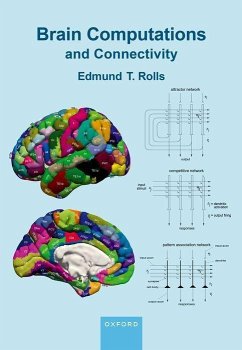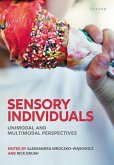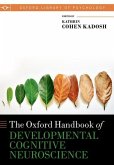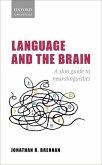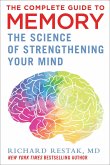Edmund T Rolls
Brain Computations and Connectivity
Edmund T Rolls
Brain Computations and Connectivity
- Gebundenes Buch
- Merkliste
- Auf die Merkliste
- Bewerten Bewerten
- Teilen
- Produkt teilen
- Produkterinnerung
- Produkterinnerung
Brain Computations and Connectivity is about how the brain works and elucidates what is computed in different brain systems and describes current biologically plausible computational approaches and models of how each of these brain systems computes.
Andere Kunden interessierten sich auch für
![Sensory Individuals Sensory Individuals]() Sensory Individuals132,99 €
Sensory Individuals132,99 €![The Oxford Handbook of Developmental Cognitive Neuroscience The Oxford Handbook of Developmental Cognitive Neuroscience]() The Oxford Handbook of Developmental Cognitive Neuroscience219,99 €
The Oxford Handbook of Developmental Cognitive Neuroscience219,99 €![Language and the Brain Language and the Brain]() Jonathan R BrennanLanguage and the Brain72,99 €
Jonathan R BrennanLanguage and the Brain72,99 €![Musical Illusions and Phantom Words Musical Illusions and Phantom Words]() Diana DeutschMusical Illusions and Phantom Words51,99 €
Diana DeutschMusical Illusions and Phantom Words51,99 €![The Complete Guide to Memory The Complete Guide to Memory]() Richard RestakThe Complete Guide to Memory20,99 €
Richard RestakThe Complete Guide to Memory20,99 €![The Essential Howard Gardner on Mind The Essential Howard Gardner on Mind]() Howard GardnerThe Essential Howard Gardner on Mind118,99 €
Howard GardnerThe Essential Howard Gardner on Mind118,99 €![Functional Connectivity of EEG in the default network of the brain Functional Connectivity of EEG in the default network of the brain]() Rex CannonFunctional Connectivity of EEG in the default network of the brain39,99 €
Rex CannonFunctional Connectivity of EEG in the default network of the brain39,99 €-
-
-
Brain Computations and Connectivity is about how the brain works and elucidates what is computed in different brain systems and describes current biologically plausible computational approaches and models of how each of these brain systems computes.
Produktdetails
- Produktdetails
- Verlag: Oxford University Press
- 2nd edition
- Seitenzahl: 1174
- Erscheinungstermin: 11. Oktober 2023
- Englisch
- Abmessung: 250mm x 176mm x 52mm
- Gewicht: 1916g
- ISBN-13: 9780198887911
- ISBN-10: 0198887914
- Artikelnr.: 68351653
- Herstellerkennzeichnung
- Libri GmbH
- Europaallee 1
- 36244 Bad Hersfeld
- gpsr@libri.de
- Verlag: Oxford University Press
- 2nd edition
- Seitenzahl: 1174
- Erscheinungstermin: 11. Oktober 2023
- Englisch
- Abmessung: 250mm x 176mm x 52mm
- Gewicht: 1916g
- ISBN-13: 9780198887911
- ISBN-10: 0198887914
- Artikelnr.: 68351653
- Herstellerkennzeichnung
- Libri GmbH
- Europaallee 1
- 36244 Bad Hersfeld
- gpsr@libri.de
Professor Edmund T. Rolls performs full-time research at the Oxford Centre for Computational Neuroscience, and at the University of Warwick, and has performed research and teaching for many years as Professor of Experimental Psychology at the University of Oxford, and as Fellow and Tutor of Corpus Christi College, Oxford. His research links computational neuroscience to neurophysiological, human functional neuroimaging and neuropsychological studies in order to provide a fundamental basis for understanding how the brain operates in health and in disease.
* 1: Introduction
* 2: The ventral visual system
* 3: The dorsal visual system
* 4: The taste and flavor system
* 5: The olfactory system
* 6: The somatosensory system
* 7: The auditory system
* 8: The temporal cortex
* 9: The hippocampus, memory, and spatial function
* 10: The parietal cortex, spatial functions, and navigation
* 11: The orbitofrontal cortex, amygdala, reward value, emotion, and
decision-making
* 12: The cingulate cortex
* 13: The prefrontal cortex
* 14: Language and syntax in the brain
* 15: The motor cortical areas
* 16: The basal ganglia
* 17: Cerebellar cortex
* 18: Cortical attractor dynamics and connectivity, stochasticity,
psychiatric disorders, and aging
* 19: Computations by different types of brain, and by artificial
neural systems
* Appendix A: Introduction to linear algebra for neural networks
* Appendix B: Neuronal network models
* Appendix C: Neuronal encoding, and information theory
* Appendix D: Simulation software for neuronal networks, and
information analysis of neuronal encoding
* Bibliography
* Index
* 2: The ventral visual system
* 3: The dorsal visual system
* 4: The taste and flavor system
* 5: The olfactory system
* 6: The somatosensory system
* 7: The auditory system
* 8: The temporal cortex
* 9: The hippocampus, memory, and spatial function
* 10: The parietal cortex, spatial functions, and navigation
* 11: The orbitofrontal cortex, amygdala, reward value, emotion, and
decision-making
* 12: The cingulate cortex
* 13: The prefrontal cortex
* 14: Language and syntax in the brain
* 15: The motor cortical areas
* 16: The basal ganglia
* 17: Cerebellar cortex
* 18: Cortical attractor dynamics and connectivity, stochasticity,
psychiatric disorders, and aging
* 19: Computations by different types of brain, and by artificial
neural systems
* Appendix A: Introduction to linear algebra for neural networks
* Appendix B: Neuronal network models
* Appendix C: Neuronal encoding, and information theory
* Appendix D: Simulation software for neuronal networks, and
information analysis of neuronal encoding
* Bibliography
* Index
* 1: Introduction
* 2: The ventral visual system
* 3: The dorsal visual system
* 4: The taste and flavor system
* 5: The olfactory system
* 6: The somatosensory system
* 7: The auditory system
* 8: The temporal cortex
* 9: The hippocampus, memory, and spatial function
* 10: The parietal cortex, spatial functions, and navigation
* 11: The orbitofrontal cortex, amygdala, reward value, emotion, and
decision-making
* 12: The cingulate cortex
* 13: The prefrontal cortex
* 14: Language and syntax in the brain
* 15: The motor cortical areas
* 16: The basal ganglia
* 17: Cerebellar cortex
* 18: Cortical attractor dynamics and connectivity, stochasticity,
psychiatric disorders, and aging
* 19: Computations by different types of brain, and by artificial
neural systems
* Appendix A: Introduction to linear algebra for neural networks
* Appendix B: Neuronal network models
* Appendix C: Neuronal encoding, and information theory
* Appendix D: Simulation software for neuronal networks, and
information analysis of neuronal encoding
* Bibliography
* Index
* 2: The ventral visual system
* 3: The dorsal visual system
* 4: The taste and flavor system
* 5: The olfactory system
* 6: The somatosensory system
* 7: The auditory system
* 8: The temporal cortex
* 9: The hippocampus, memory, and spatial function
* 10: The parietal cortex, spatial functions, and navigation
* 11: The orbitofrontal cortex, amygdala, reward value, emotion, and
decision-making
* 12: The cingulate cortex
* 13: The prefrontal cortex
* 14: Language and syntax in the brain
* 15: The motor cortical areas
* 16: The basal ganglia
* 17: Cerebellar cortex
* 18: Cortical attractor dynamics and connectivity, stochasticity,
psychiatric disorders, and aging
* 19: Computations by different types of brain, and by artificial
neural systems
* Appendix A: Introduction to linear algebra for neural networks
* Appendix B: Neuronal network models
* Appendix C: Neuronal encoding, and information theory
* Appendix D: Simulation software for neuronal networks, and
information analysis of neuronal encoding
* Bibliography
* Index

